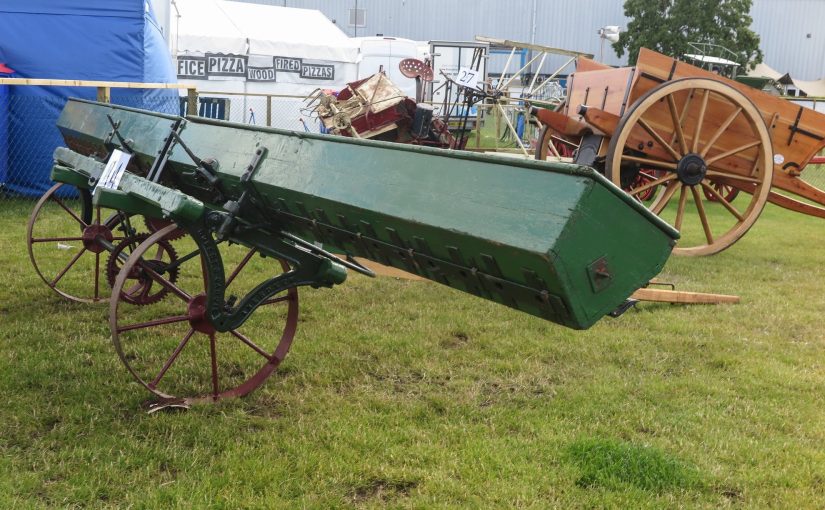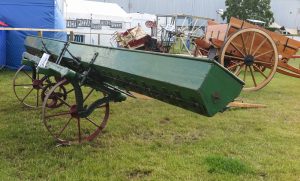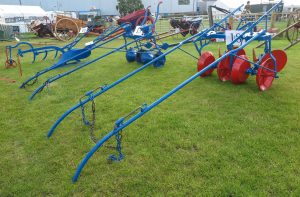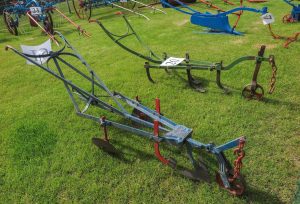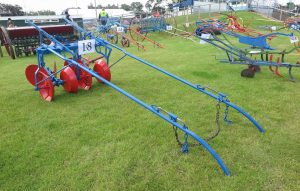The 1932 show of the Royal Highland and Agricultural Society of Scotland was held in the Inverness Show District, in Inverness. The Scotsman reported the display of implements and machines in its issue of 21 June 1932. This included the manufactures from the Scottish makers. It is worth quoting at length to show what was available for the agriculturist in 1932 at a time of economic difficulty when mechanisation had been making inroads into agriculture.
“Inverness Highland Show
The highland capital yesterday presented a bustling and animated appearance, the town being crowded with visitors for the Highland and Agricultural Society’s Show, which opens to-day. The hotels are fully occupied, and there has been. Great run on available accommodation in private houses, while large numbers have overflowed to the neighbouring towns. The sky was overcast in the morning; the early part of the day was dull and cool; but in the afternoon the sun shone brightly, and the weather prospects are very promising. Although there is not such an extensive show of implements as at Edinburgh last year, there is an attractive exhibition of all that is useful on the farm. Considering the distance of Inverness from the more important centres of commercial and manufacturing industries in the South, the display is very satisfactory, and is greater than in any previous Inverness Show.
Thoroughly comprehensiveIn the implement yard exhibitors were fully occupied yesterday getting their stands in order, The comprehensive character and number of exhibits comprised in the section well upholds the traditions of the Society. There are 245 stands, with 1926 exhibits representing practically every department of commerce catering for those engaged in the cultivation of land, or in the breeding and feeding of live stock. The yard has been so arranged by Professor Stanfield, M.InstC.E., Edinburgh, the Society’s consulting engineer, and the various kinds of exhibits have been so grouped that the visitor may make a round of inspection in the most convenient and quickest way.
Only four implements were shown at the first Inverness Show in 1831. They were six times that number in 1839, 59 in 1846, 231 in 1856, and 707 in 1865; but they reached four figures in 1874. Nine years later they numbered 1280, and in 1892 they were 1383. Still mounting up, the number was 1463 in 1901, and ten years later 1513. In 1923 the entries were 1778; and on this occasion, as already noted, the total is 1926. The principal Scottish implement makers are represented in the Show, and the leading English firms are also forward. The exhibits demonstrate the perfection to which the agricultural engineer has brought farm machinery, and visitors of a practical mind will find much of interest and instruction in their inspection. All manner of farm implements are embraced within the comprehensive display which is laid out to good advantage on the showground. Manufacturers from many parts of the country are represented in the vast collection, and nothing which is of the least use to the agriculturist in the pursuit of his calling has been overlooked. The display, while it is of the greatest interest to the practical farmer, will also be a source of much attraction to the members of the general purpose.
Sowing and cultivating machinery is to be found in variety on stand no. 87, occupied by J. L. & J. Ballach, Gorgie Implement Works, Edinburgh. Included in the assortment is the patent universal expanding disc drill scarifier, for drills from 18 to 30 inches wide. Fitted with patent hoeing attachments, this machine gained the H. and A. S. silver medal at the 1927 show at Edinburgh. Several specimens of the new champion turnip sower are also forward together with broadcast manure distributors, combined turnip and manufacture sowers, potato sowers, sorters, horse hoes, ball-bearing grinders. Thomas Sherriff & Co., West Barns, Dunbar, are at stand no. 81, with a display of their popular implements. One of these is the combined turnip and beet sower and hoer, which sows four rows on the flat from 18 to 26 inches apart. It was awarded the Society’s silver medal at the Edinburgh Show, 1927. Grain and seed drills, steel frame broadcast seed sowers, drills for peas and beans, land measures, and a new improved land measuring wheel or sheep drains, &c, are also on view.
Tractors and transport
Notable among the motor exhibits are those seen at stand no. 131. There Henry Alexander & Co., Nottingham Place, Edinburgh, have an interesting and varied display, including an agricultural Fordson tractor fitted with a hay mower, a three-furrow Oliver plough, an Elwick cultivator with ridging bodies and Miller non-slip wheels. There is also an Enfield lawn mower, which is claimed to be the cheapest machine of its kind on the market. The Ford 8hp Tudor saloon on view is the new model that is being manufactured at Dagenham, and in which much public interest is being shown. Other exhibits are Ford two-ton and one-ton trucks, a Ford forward control truck capable of carrying two and a half tons, and a Ford forward control three-purpose truck. The Morris Commercial Cars (Ltd), Birmingham, are exhibiting through their local agents, Macrae & Dick (Ltd), at stand no. 135, a wide range of vehicles. Exhibits of special interest to farmers and stockbreeders include a tow-ton farm and estate lorry. It is designed with a loading ramp to carry cattle, or it can be used as an ordinary lorry for general farm work. A three-ton cattle truck, which is also on view, is fitted with an upper deck for carrying sheep or pigs. This deck is removable, and there are low ramps at the rear and sides for loading cattle.
At stand no. 77 William Kinross & Sons, 37 Port Street, Stirling, are displaying a selection of milk lorries, some with iron tyres, and others rubber tyred. The latter type of lorry is being used by an increasing number of dairymen. Spring carts and floats are also shown at this stand.
Dairy outfitters
G. D. L. Swann & Son, dairy engineers and outfitters, 32-36 Abercorn Street, Glasgow, are at stand no. 64, where they display a range of bottle-filling as well as washing machines, varying in capacity from one suiting a dairyman handling 20 gallons a day to one distributing 1000 gallons. The firm fit up dairies for graded milk at the farm or for a town depot. Messrs Swann present a great assortment of bottles, discs, caps, cases, seamless milk cans, delivery barrows, &c. All the goods on view are entirely of British manufacture, while tanks, pails, luggies, carrying cans, &c, are all made in the firm’s Glasgow works. Latest in poultry houses.
Cowiesons (Ltd), 3 Charles Street, St Rollox, Glasgow, are well-known for their poultry houses and appliances, summer houses, tool sheds, and such like structures, specimens of which are displayed at stand no. 178. Their “Caledonia” poultry house is the last word in regard to these houses, and it is proving immensely popular with breeders all over the country. The revolving summer house on view is an attractive structure, of great lasting qualities, and attractively finished. A visit to the stand will prove time well spent, as there is much of interest to be seen. Poultry breeders will find many exhibits of interest at stand no. 176, occupied by G. Sutherland & Sons, Premier Works, Forres, who make a speciality of poultry houses and appliances. The firm also make allotment huts and garden shelters, and a selection of these are also on view. Robert Miller (Denny) (Ltd), Bonnybridge, are showing various models of their make of poultry houses at stand no. 179.”
Do recognise any of the implements and machines or names of their makers?
